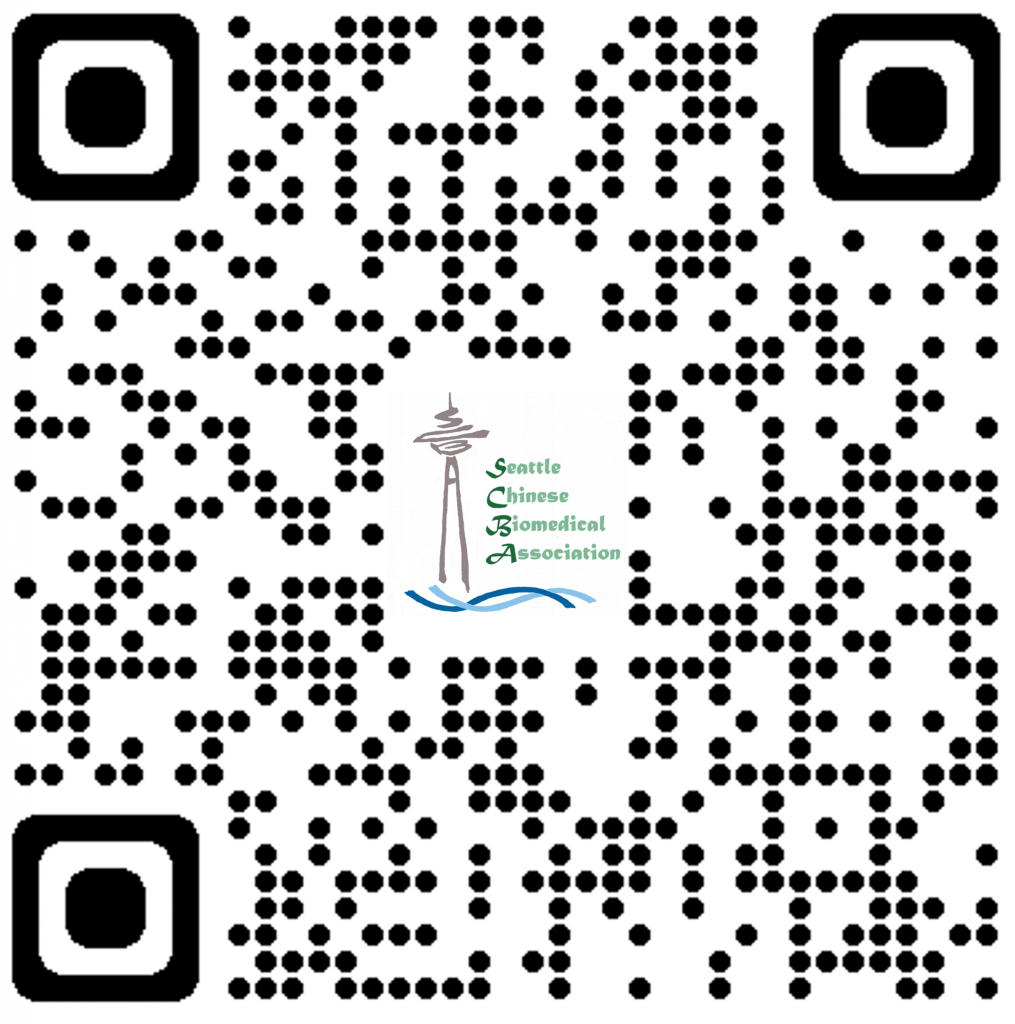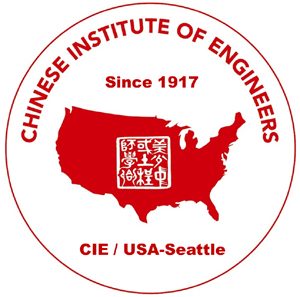2021年全体会员大会暨年会
2021 Annual Conference
Theme: Neuroscience
![]()
DATE, ZOOM INFO & AGENDA
Annual conference link QR code.
Scan to open on a cell phone.
♦ Saturday, Dec. 18th, 2021
♦ Zoom Meeting ID: 987 2120 1616 (passcode: scba2021)
♦ Detailed agenda (Pacific Standard Time, 太平洋时间)
2:30 PM – 3:00 PM Check-in and social time
3:00 PM – 3:10 PM Dr. Haodong Xu徐浩东 博士 致开幕词
3:10 PM – 3:55 PM Invited Speaker Dr. Hongkui Zeng曾红葵 博士
3:55 PM – 4:40 PM Invited Speaker Dr. Jihong Bai白继红 博士
4:40 PM – 5:00 PM Announcement for 2022 SCBA-Sino Biological Young Investigator Award and SCBA Summer Intern Program for High School Students; Sponsor Presentation and Meeting Break
5:00 PM – 5:45 PM Invited Speaker Dr. Jing Zhang 章京 博士
5:45 PM – 6:30 PM Invited Speaker Dr. Bailong Xiao 肖百龙 博士
6:30 PM – 6:45 PM Dr. Haodong Xu 徐浩东 博士 协会年度工作报告
6:45 PM – 6:55 PM Other Business 协会其它事项之讨论
6:55 PM – 7:00 PM Dr. Jie An安杰 博士 致闭幕词
7:00 PM – Meeting adjournment & Social time
![]()
MEETING/MEMBERSHIP REGISTRATION
Meeting scientific programs are open and free to all attendees.
Registered SCBA members have the rights to vote and to be elected plus free meeting dinner and free or reduced summer BBQ for future in-person events.
The 2021 membership fee is waived due to COVID-19 pandemic except for permanent members, for all old and new members, please register either online http://scbahome.org/membership or through SCBA email office@scbahome.org to become an active SCBA member.
![]()
DISTINGUISHED ACADEMIC SPEAKERS
Hongkui Zeng, Ph.D. (曾红葵 博士)
Executive Vice President and Director, Allen Institute for Brain Science
“Understanding Brain Cell Type Diversity”
Dr. Hongkui Zeng is Executive Vice President and Director of Allen Institute for Brain Science. Since joining the Allen Institute in 2006, she has led multidisciplinary teams to develop large-scale, high-throughput transcriptomics, connectomics and multimodal platforms and use them to characterize and classify the wide variety of cell types that constitute the mammalian brain, laying the foundation for unraveling the cell type basis of brain function. Her work has led to widely adopted community resources and standards, including transgenic mouse lines, Allen Mouse Brain Connectivity Atlas, the Common Coordinate Framework (CCF) and the brain-wide transcriptomic cell type taxonomy. Zeng received her Ph.D. in molecular and cell biology from Brandeis University and postdoctoral training in neuroscience at Massachusetts Institute of Technology. She has received many honors, including the 2016 AWIS Award for Scientific Advancement and the 2018 Gill Transformative Investigator Award.
Abstract
To understand the function of the brain and how its dysfunction leads to brain diseases, it is essential to uncover the cell type composition of the brain, how the cell types are connected with each other and what their roles are in circuit function. At the Allen Institute, we have built multiple platforms, including single-cell transcriptomics, spatial transcriptomics, single and multi-patching electrophysiology, 3D reconstruction of neuronal morphology, and high throughput brain-wide connectivity mapping, to characterize the transcriptomic, physiological, morphological, and connectional properties of brain cell types in a systematic manner, towards a multi-modal cell atlas for the mouse and human brain. These studies reveal extraordinary cellular diversity and underlying rules of brain organization and lay the foundation for unraveling mechanisms of circuit function.
Towards the goal of creating a cell atlas for the entire mouse brain, we have generated single-cell transcriptomes from many parts of the mouse brain. A comprehensive transcriptomic cell type taxonomy across the mouse isocortex and hippocampal formation reveals a parallel cell type and circuit organization between these two major brain structures and large-scale continuous gradient distribution of cell types in multiple dimensions in both structures, suggesting evolutionary and developmental underpinnings of the adult-stage cell type landscape.
To better understand the relationship between cell types, transcriptomic profiles and other structural and functional properties, we used Patch-seq to characterize the transcriptomic, physiological and morphological properties of mouse cortical GABAergic interneurons and complete morphology reconstruction of molecularly defined long-range projection neurons from various brain regions. These studies reveal concordant phenotypic variations at major cell type level as well as differential variations at more fine-grained subtype and individual cell levels, suggesting an interplay of genetic programming and network interaction in shaping the cellular diversity in the brain.
Jihong Bai, PhD (白继红 博士)
Associate Professor, Basic Sciences Division, Fred Hutchinson Cancer Research Center
“Transient Endosomes at Synapses”
Dr. Jihong Bai received his undergraduate degree from Beijing Agricultural University, and a master’s degree from Tsinghua University. He later joined the Biophysics Ph.D. Program at the University of Wisconsin-Madison. After receiving his Ph.D., he moved to Boston and joined the laboratory of Joshua Kaplan at Harvard Medical School to study neurobiology using the nematode C. elegans. He joined Fred Hutchinson Cancer Research Center and started his lab in the winter of 2011 and became Associate Professor in 2016.
Abstract
The long-term interest of my lab is to elucidate molecular, cellular, and circuit mechanisms governing neuron communication and animal behavior. In particular, we want to understand two processes that determine the flow of information in neural circuits. First, we study how synaptic proteins control the endocytosis, an essential process that sustains synaptic transmission between individual neurons. Second, we investigate how neurons form functional circuits to couple sensation to behavior. In this seminar, I will report our recent findings on endocytic mechanisms governing the quality of synaptic communication. I will discuss the protein machinery that acts to replenish the supply of synaptic vesicles and its impacts on transient endosomes in neurons.
Jing Zhang, MD, PhD (章京 博士)
Professor, Director of National Human Brain Bank for Health and Disease, Director of Pathology Center, Zhejiang University. Vice-president of Yuhang Campus and Director of Pathology department, The First Affiliated Hospital, Zhejiang University School of Medicine
“Decoding Neurodegenerative Diseases with Blood Biomarkers Contained in Extracellular Vesicles ”
2020年初作为讲席教授加盟浙江大学、现任浙江大学“国家健康和疾病人脑组织资源库”主任、第一附属医院余杭院区副院长、浙江大学病理中心及第一附属医院病理科主任。回国前任华盛顿大学医学院神经病理科主任医师(担任神经病理科主任至2016年2月), 教授和冠名讲席教授 (Shaw Endowed Professor)
科研方向:在用分子标志物进行帕金森病(PD)、阿尔茨海默氏病(AD)等神经退行性疾病的早期诊断、追踪等转化医学研究上处于国际前沿,并获2013年国际AD生物标志物研发奖。在国际上首创了从质谱分析筛选到独立平台验证的研究流程,首次确认了脑脊液α-syn、磷酸化α- syn、Aβ、tau 等在PD早期诊断及鉴别诊断中的临床应用价值,同时参与制定了由美国NIH及MJFF基金会PD生物标志物联盟组织的、体液生物标志物测定及实验室室间质控国际标准。近期在国际上首创了从体液中捕获脑源性外泌体的技术,并首次报道了血浆外泌体中的α-syn 和tau、唾液中α-syn等的潜在应用价值,获得了1 项国际专利。该技术突破了从周边体液中进行脑源性分子组学研究的技术瓶颈,开创了通过外周体液进行脑内疾病无创性早期诊断的新局面。同时,基于周边体液外泌体转运的理论,首次推出了“红细胞中α-syn在PD发病及进展中的关键作用”的假说。
论文:从1984年起,已发表~250篇SCI相关文章,总引用数>19,000次,h-指数:74 (引用超过100次的>60篇); i10-指数:189。
Abstract
Gold standard of diagnosing neurological diseases is traditionally via tissue biopsy or, at least, measuring biomarkers in cerebrospinal fluid (CSF); both approaches are considered “invasive” and “unfriendly”. With advances in technology and biology of extracellular vesicles (EVs), it is now possible to capture disease-related essential molecular molecules derived from CNS using a peripheral sample, including blood that is obtained with much more “friendly” method. In this lecture, the background, technology and application of this line of research will be reviewed, with an emphasis on diagnosing Alzheimer’s disease early and precisely.
Bailong Xiao, PhD (肖百龙 博士)
Principal Investigator, School of Pharmaceutical Sciences, Tsinghua-Peking Joint Center for Life Sciences, IDG/McGovern Brain Research Institute, Tsinghua University
“Feeling force with the mechanosensitive Piezo channels”
Professor Bailong Xiao is a world-class investigator and a leader in the mechanosensitive ion channel field. He obtained his B.S. degree from the Sun Yat-sen University in 2001 and his Ph.D degree from the University of Calgary in Canada from 2006. His Ph.D dissertation was focused on the structure-function relationships and physiological roles of the cardiac Ryanodine Receptor. From 2007 and 2012, Dr. Xiao completed his postdoctoral training with Dr. Ardem Patapoutian at the Scripps Research Institute in the United States, where he made important contributions to the establishment of the mechanosensitive Piezo channel family and the studies of the molecular and cellular mechanisms underlying the sensation of touch and pain. He joined the faculty of Tsinghua University in 2013, where he has established a multidisciplinary research program to advance the understanding of the structure-function relationships as well as physiological and pharmacological regulations of Piezo channels. He was promoted to tenured Associate and Full Professor in 2018 and 2021, respectively.
Abstract
The evolutionarily conserved Piezo channel family, including Piezo1 and Piezo2 in mammals, serves as versatile mechanotransducers in various cell types and consequently governs fundamental pathophysiological processes ranging from vascular development to the sense of gentle touch, proprioception and tactile pain. Piezo1/2 possesses a unique 38-transmembrane helix (TM)-topology and forms a homotrimeric propeller-shaped structure comprising a central ion-conducting pore and three peripheral mechanosensing blades. The unusually curved transmembrane region of the three blades shapes a signature nano-bowl configuration with potential to generate large in-plane membrane area expansion, which might confer exquisite mechanosensitivity to Piezo channels. In this talk, I will introduce the history of the Piezo channel discovery that has led to the 2021 Nobel Prize in Physiology or Medicine to Dr. Ardem Patapoutian and our current understanding of Piezo channels with a particular focus on their unique structural designs and elegant mechanogating mechanisms.
![]()
COPYRIGHT DISCLAIMER
The SCBA 2021 Annual Conference is being conducted over Zoom. This conference will not be recorded. To protect unpublished materials presented during the conference, video or audio recording of lectures or the photography of slide by any means, including but not limited to taping, recording, photographing, screen capture and other methods of capture, by any participants for any purposes is prohibited. Thank you for your cooperation!
西雅图华人生物医学协会 2021年学术年会在Zoom上进行。该会议将不作任何录音或录像等记录。为了保护会议期间演示的未出版材料,禁止任何与会者对演讲内容包括幻灯片进行录像、录音、拍照、截屏以及其它任何方式的录制。谢谢合作!
![]()







